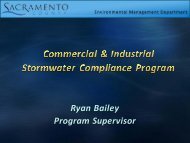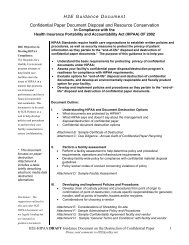Reducing Dental X-Ray Chemical Use
Reducing Dental X-Ray Chemical Use
Reducing Dental X-Ray Chemical Use
You also want an ePaper? Increase the reach of your titles
YUMPU automatically turns print PDFs into web optimized ePapers that Google loves.
<strong>Reducing</strong> <strong>Dental</strong> X-<strong>Ray</strong><br />
<strong>Chemical</strong> <strong>Use</strong><br />
A Pollution Prevention Perspective<br />
In Brief<br />
We conducted a survey of dental radiography in the San Francisco area. This<br />
survey was part of a cooperative project sponsored by the California <strong>Dental</strong><br />
Association, local dental societies, city agencies, and the US Environmental<br />
Protection Agency. Our dental co-researchers who responded to the survey told<br />
us:<br />
• average number of exposures = 70 / dentist / week;<br />
• spoiled exposures = 2 / dentist / week, or about 3%, with main causes<br />
being patient movement, film orientation, and developing problems; and<br />
• developer and fixer use on average = 0.5 oz each / exposure.<br />
These responses give us clues on how dental practices can reduce their<br />
radiographic chemical use<br />
• Check developer & fixer use.<br />
If significantly above 0.5 oz<br />
per exposure, then<br />
investigate why. Also, check<br />
product mixing instructions to<br />
assure that you are following<br />
manufacturer guidelines;<br />
• Decrease spoiled exposures<br />
by resolving film orientation<br />
and film processing issues;<br />
and<br />
• If feasible, change to digital<br />
radiography.<br />
The last two of these approaches have the important added benefit of decreasing<br />
patient and staff exposure to x-ray emissions.<br />
<strong>Dental</strong> P2 Project 1 September 2005
<strong>Reducing</strong> <strong>Dental</strong> X-<strong>Ray</strong> <strong>Chemical</strong> <strong>Use</strong><br />
The Details<br />
1 How many radiographic images do dental practices typically make<br />
each week As shown by the table, the average is 70 images per<br />
dentist.<br />
Survey Results: Radiographic Images Made<br />
X-<strong>Ray</strong> Images / Week<br />
Minimum Average Maximum<br />
Regular 0 115.6 650<br />
Panoramic 0 1.1 18<br />
Weekly X-<strong>Ray</strong> Images Per Dentist<br />
Minimum Average Maximum<br />
Regular 0 70.2 500<br />
Panoramic 0 0.6 10<br />
2 How many spoiled radiographic images occur On average, 3.3%.<br />
Individual offices report that from 0% to 29% of their x-ray images are<br />
spoiled. The pie chart below shows that patient movement, wrong film<br />
orientation, and film developing problems account for most of these<br />
spoiled exposures.<br />
Survey Results: Causes of Spoiled X-<strong>Ray</strong> Exposures<br />
Under / Over<br />
Exposed<br />
Bad Film<br />
Other<br />
Patient<br />
Movement<br />
Developing<br />
Problems<br />
Wrong Film<br />
Orientation<br />
<strong>Dental</strong> P2 Project 2 September 2005
<strong>Reducing</strong> <strong>Dental</strong> X-<strong>Ray</strong> <strong>Chemical</strong> <strong>Use</strong><br />
3 What chemicals do dental practices use to process radiographic<br />
film<br />
Most offices purchase pre-packaged film developer and fixer, and replace<br />
these in their film processors either weekly or on some other routine<br />
schedule. Some practices also use special maintenance products.<br />
The following table and chart show that there is significant variation in the<br />
amounts of these chemicals that the survey respondents use. Further, the<br />
average use of 0.5 ounce of developer or fixer per image is significantly<br />
more than the 0.1 ounce per image guideline recommended by many film<br />
processor vendors.<br />
Survey Results: Radiographic <strong>Chemical</strong> <strong>Use</strong><br />
Film Processing <strong>Chemical</strong> <strong>Use</strong><br />
Minimum Average Maximum<br />
Total Amounts Per Office (Ounces/week)<br />
Developer 0.1 43 384<br />
Fixer 0.1 40 384<br />
Actual Amounts Per Image (Ounces/Image)<br />
Developer 0.001 0.51 3.2<br />
Fixer 0.001 0.48 3.2<br />
Typical Manufacturer Guideline (Ounces/Image)<br />
Developer 0.09 0.10 0.21<br />
Fixer 0.09 0.10 0.21<br />
10<br />
8<br />
6<br />
4<br />
2<br />
0<br />
0 100 200 300 400 500 600 700 800<br />
Exposures Per Week<br />
Note: Chart for fixer use is similar.<br />
<strong>Dental</strong> P2 Project 3 September 2005
<strong>Reducing</strong> <strong>Dental</strong> X-<strong>Ray</strong> <strong>Chemical</strong> <strong>Use</strong><br />
4 What are the health, safety, and environmental hazards of typical film<br />
processing chemicals<br />
Product Material Safety Data Sheets (MSDSs) and other literature list the<br />
following typical ingredients and hazards for film developer and fixer.<br />
Typical Hazards of Radiographic <strong>Chemical</strong>s<br />
Typical Amounts<br />
Hazards [1]<br />
Ingredient CAS Wt. % g/Exp. Human Enviro<br />
Developer<br />
Potassium Hydroxide 1310-58-3 2% 0.010 Severe Eye High pH<br />
Sodium Sulfite 7757-83-7 8% 0.041 Allergen/Sens<br />
Hydroquinone 123-31-9 2% 0.010 Tox/Sens Aq Tox<br />
Glutaraldehyde 111-30-8 3% 0.015 Eye/Skin/Aller [2]<br />
Fixer<br />
Ammon. Thiosulfate 7783-18-8 15% 0.071<br />
Sodium Sulfite 7757-83-7 2% 0.010 Allergen/Sens<br />
Acetic Acid 64-19-7 3% 0.014 Eyes<br />
[1] Legend Other Notes<br />
g/Exp = grams per exposure [2] Possible mutagen - CA DPR Tox Data Summary 139 (2002)<br />
Tox/Sens = Toxic / Sensitizer<br />
Aq Tox = Aquatic Toxicity<br />
These ingredients pose modest to significant worker health hazards,<br />
making it advisable for a person handling film processor chemicals to wear<br />
gloves & goggles, and to have a good supply of fresh air. Persons with<br />
asthma and other sensitivities should take particular care to limit their<br />
exposure.<br />
5 How many dental practices use digital radiography About 28%.<br />
Twenty-three percent of the survey respondents use only digital<br />
radiography, while an additional 5% are 'in transition' and use both digital<br />
and film.<br />
Nineteen percent of the surveyed offices say that they are seriously<br />
considering making the change to digital within the next 2 years.<br />
Most of the survey respondents appear quite knowledgeable about digital<br />
radiography, and have opinions about the pros & cons of such systems.<br />
<strong>Dental</strong> P2 Project 4 September 2005
<strong>Reducing</strong> <strong>Dental</strong> X-<strong>Ray</strong> <strong>Chemical</strong> <strong>Use</strong><br />
Advantages of Digital Radiography<br />
(Comments made by % of survey respondents)<br />
No <strong>Chemical</strong>s Cost<br />
27.8% 27.1%<br />
Patient Less Radiation Discomfort<br />
Bulky/Using Up Speed Space<br />
Computer Image Manipulation Dependent<br />
5.6% 6.3%<br />
16.7%<br />
16.7%<br />
22.9%<br />
22.9%<br />
Image Less Waste Quality<br />
Other Other<br />
4.2% 5.6%<br />
16.7%<br />
27.8%<br />
0% 0% 5% 5% 10% 15% 20% 25% 25% 30% 30%<br />
Source: SF Area <strong>Dental</strong> Offices<br />
Disadvantages of Digital Radiography<br />
(Comments made by % of survey respondents)<br />
Cost<br />
27.8%<br />
Patient Discomfort<br />
Bulky/Using Up Space<br />
Computer Dependent<br />
5.6%<br />
16.7%<br />
16.7%<br />
Image Quality<br />
Other<br />
5.6%<br />
27.8%<br />
0% 5% 10% 15% 20% 25% 30%<br />
Source: SF Area <strong>Dental</strong> Offices<br />
<strong>Dental</strong> P2 Project 5 September 2005
<strong>Reducing</strong> <strong>Dental</strong> X-<strong>Ray</strong> <strong>Chemical</strong> <strong>Use</strong><br />
How To Reduce Your X-<strong>Ray</strong> <strong>Chemical</strong> <strong>Use</strong><br />
Take a quick inventory of your radiographic film and processing chemicals,<br />
and estimate the amounts of each product that you use each week.<br />
You may discover old, outdated products in your storage area. Dispose of<br />
these properly (e.g., unused developer with hydroquinone is a hazardous<br />
waste), and in the future buy just the amount that matches your<br />
consumption. Results to expect: You can reduce your chemical use by<br />
up to perhaps 10%, depending upon the details of how your practice has<br />
been ordering supplies.<br />
If you use more than the average amounts of developer and fixer that we<br />
found to be typical (i.e., 0.5 liquid ounce of each per exposure), then<br />
consider extending the time between chemical changes in your processor.<br />
• First check that you are following the chemical replenishment<br />
directions from the manufacturer. For example, the maintenance<br />
manual for one popular processor says to change the chemistry<br />
every 2 weeks or after 300-350 exposures, which ever comes first.<br />
• If you are consuming more than these guidelines, then consider<br />
changing your chemistry less often. Of course, take care not to go<br />
so far that image quality is degraded.<br />
Results to expect: The outcome will vary with the specifics of your<br />
situation, but you may see a reduction of up to perhaps 50% in developer<br />
and fixer use.<br />
Estimate the number of radiographic images that your office spoils each<br />
week, and identify the most common causes.<br />
If your image spoilage rate is above 3%, carefully evaluate how you take<br />
exposures and process the film.<br />
Operator refresher training and attention to processor maintenance and<br />
chemistry replenishment will significantly decrease spoilage.<br />
Results: You can reduce your spoiled images by 50% to 60% by<br />
eliminating operator exposure errors and processing problems.<br />
As a final step, consider converting to digital radiography. Many offices<br />
make such a change when either installing or upgrading a computer system used<br />
for managing patient records, practice finances, and other data.<br />
<strong>Dental</strong> P2 Project 6 September 2005
<strong>Reducing</strong> <strong>Dental</strong> X-<strong>Ray</strong> <strong>Chemical</strong> <strong>Use</strong><br />
Where To Get More Information<br />
<strong>Dental</strong> supply vendors and manufacturers usually have MSDSs and other<br />
product literature available for downloading on their websites.<br />
Digital radiography is discussed in vendor literature, society journals, and trade<br />
magazines. It also is very helpful to visit the practice of an associate who has<br />
already converted from film to digital.<br />
Health, safety, and environmental issues related to specific ingredients of<br />
radiographic processing chemicals may be researched via the following:<br />
http://www.soeh.ubc.ca/research/Report_2001/radiog.pdf<br />
http://atsdr1.atsdr.cdc.gov/toxfaq.html<br />
http://toxnet.nlm.nih.gov/<br />
http://ehp.niehs.nih.gov/docs/montharch.html<br />
http://www.state.nj.us/health/eoh/rtkweb/rtkhsfs.htm<br />
http://www.osha-slc.gov/SLTC/dentistry/index.html<br />
About The Project<br />
The project team worked under a grant from Region IX of the US Environmental<br />
Protection Agency. Co-researchers include staff from: California <strong>Dental</strong><br />
Association; Cities of San Francisco, Palo Alto, and Richmond; Mid-Peninsula<br />
<strong>Dental</strong> Society; San Francisco <strong>Dental</strong> Society; Union Sanitary District; and the<br />
University of Nevada - Reno.<br />
The project goals are to identify, characterize, and quantify chemicals used by<br />
dental professionals for radiography, infection control, and restorative work.<br />
In late 2004 the project team mailed, FAXed, and hand-delivered a 2-page<br />
survey about dental radiography to 450 dental offices in the San Francisco Bay<br />
Area. Just over 100 dental practices chose to participate in the project, for a<br />
response rate of about 25%.<br />
We invite your comments. http://www.westp2net.org/studies.cfm<br />
<strong>Dental</strong> P2 Project 7 September 2005








![Dental Amalgam Use [pdf]](https://img.yumpu.com/33828185/1/190x245/dental-amalgam-use-pdf.jpg?quality=85)




